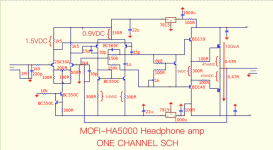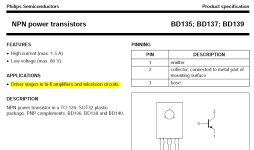I want to use either the BD139/BD140 or the MJE243G/MJE253G pairs as driver transistors for a low power amp. I have around 100 BD130/BD140 pairs with an hfe of around 200 and getting numbers of perfectly matched (<1%) pairs is not a problem. On the other hand the MJE243G/MJE253 are a mixed bag with hfe ranging from 80 to 140. I get probably get around 15% of pairs matched to within 5%. I realist that by themselves the MJE243G and MJE253G are better transistors. Which would you use?
Try both in your circuit and measure/listen to them. Let reality decide. As a driver in a low power amplifier, if the circuit is not bizarre, they should compare relatively the same. Lot of IFs though.
Most folks would ask to see the circuit at hand before dropping a decision/point of view.
Most folks would ask to see the circuit at hand before dropping a decision/point of view.
The MJE's are a bit stronger, which is not that important for drivers, but as a consequence they have a much lower Ft and higher capacitances, which could be detrimental
The circuit is a Chinese knock off of the AT HA-5000, which is in turn based on the Hitachi mosfet power amp. I rather like the Hitachi mosfet power amp but have never tried it with headphones. I suspect that from a purely engineering standpoint the BD139/BD140 (STI) might give lower distortion because of the higher hfe, despite the lower ft ( probably around 4-10Mhz).


Last edited:
BD139/40 should have much higher Ft than what you have stated, around 40-50Mhz. A very good driver transistor pair.
Are you sure about that? The Philips originals had something like ~150MHzBD139/BD140 (STI) might give lower distortion because of the higher hfe, despite the lower ft ( probably around 4-10Mhz.
No not at all sure. The datasheets don't give a figure for ft so I always assumed that it was quite low. Has anyone measured it or know for certain what the value is?
My understanding is that the modern versions of the BD139/BD140 are inferior to the Philips (unobtainium) version. Mine are ST Microelectronics and their datasheet does not quote a value for ft.
It’s not “low”, it’s just not 190 MHz anymore. 50+ depending on who made it or when. MJE243 is about 40 MHz. But BD139’s (even ST or Fairchild) are free from quasi-saturation (beta falling drastically at low Vce) and on a low voltage power supply, that’s worth something. And MJE243’s beta falls at both low and high current, and BD139 only falls at high current. That’s worth something too.
Yes, you may very well do that. For prototypes, breadboards, general experimenting. But when building something intended to be permanent I tend to pick parts based on their technical merits and then leave it alone. Eventually you lift the pads off the board jacking with things. Or fry something unrelated that you have to go back and fix. The set of “technical merits” MAY include such things as preference based on early experiments or other experience, or using what’s on hand instead of buying something else. Both perfectly valid. But on the other 3 parameters being compared here - fT, SOA, and beta linearity, BD139 is a hands down winner in this application. No it doesn’t win on SOA, but on this voltage no one could ever care.
I've used TTC004B/TTA004B pairs in lieu of BD139/BD140 a few times as drivers without issue and they are readily available.
hFE 140, FT 100MHz, Ic 1.5A, Pd 10W.
hFE 140, FT 100MHz, Ic 1.5A, Pd 10W.
They will work without problems. But they do have an 80V version which performs better at low voltage (C015/A008) that is more comparable to an actual BD. If you only wanted to keep one type in stock it would be the 004’s. Universal replacement in 99% of modern stereo receivers which still use class AB. They also have a 230V version which is their old C4793 repackaged, but again as voltage rating increases its low voltage characteristic suffers.
BD139/BD140 are no audio transistors.
MJE243G/MJE253G I do not know.
Complementary transistors sound very different: you get two different sounding half waves: the ear does detect this: it sounds dirty, cloudy, smeared, dark, potty...-(
MJE243G/MJE253G I do not know.
Complementary transistors sound very different: you get two different sounding half waves: the ear does detect this: it sounds dirty, cloudy, smeared, dark, potty...-(
Would you think the datasheet is wrong?BD139/BD140 are no audio transistors.
Hmm... deployed in tens of thousands of audio units over decades in my observation.BD139/BD140 are no audio transistors.
MJE243G/MJE253G I do not know.
porky…Complementary transistors sound very different: you get two different sounding half waves: the ear does detect this: it sounds…
potty...-(
there, fixed it for ya
/s
- Status
- Not open for further replies.
- Home
- Amplifiers
- Solid State
- BD139/BD140 dilemma
